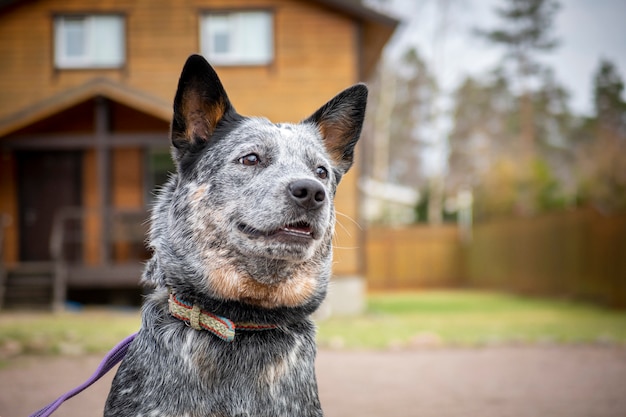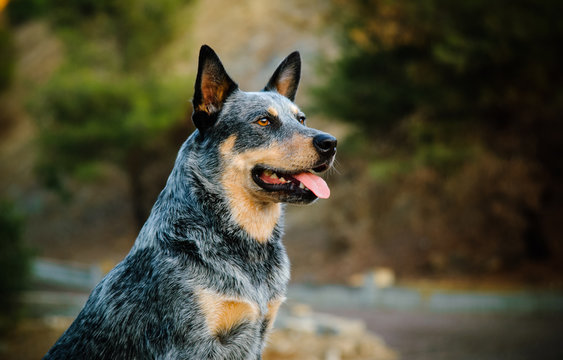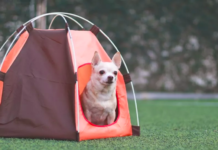Last Updated on July 2, 2021 by Fumipets
The Blue Heeler, also known as the Australian Cattle dog, is a hardworking, clever, and loyal dog. They were originally developed to be herding dogs on farms, and they continue to flourish in this role when given a task to perform. Because of their strong commitment, they are even better workers. If you do not work on a farm, you may still put them to good use in your home. They have a lot of fun solving puzzles and fetching toys.
Blue Heelers are very loyal to their owners and are often referred to as “shadow dogs” because of their devotion to them. These animals develop a strong attachment to their owners and despise the thought of being removed from them. This is a very active breed that will gladly join you on your next run or hike if you have the opportunity.
History of the Blue Heeler
During the nineteenth century, Australian settlers developed the Blue Heeler to herd cattle on their ranches. Australian beef producers attribute much of their success to the breed’s ability to use their skills to effectively develop the Australian beef business.
Ranchers created a robust and powerful canine after numerous breedings and cross-breedings to ensure that it could withstand the severe environment of Australia. When dogs from England were introduced to Australia, they were mated with the indigenous Australian Dingo to produce the progenitors of the Blue Heeler that we know today.
The American Kennel Club approved the Australian Cattle Dog for registration in May 1980, making it the first breed to do so. In September of that year, the breed became eligible for exhibition in the Working Group, and it was later moved to the Herding Group in 1983.

Caring for the Blue Heeler
A Blue Heeler’s life would be incomplete without regular exercise. Because of its industrious ancestors, the breed needs frequent physical and mental stimulation in order to maintain their happiness. Puzzle toys and retrieve games are excellent hobbies for Blue Heelers since they like having a task to do.
It’s best not to leave your Blue Heeler alone for extended periods of time, particularly in confined places, so bring your companion along whether you’re going for a stroll, a hike, or a swim.
In the absence of a channel for its energy, the Blue Heeler may grow bored and destructive, chewing on shoes or other furnishings. This breed prefers to live in homes with a fenced yard or a large, safe yard to run about in.
The Blue Heeler will herd anything that moves, including children and other pets. As a result, Blue Heelers need early socialisation and training to ensure that they learn which actions are undesirable in the future. If they are not properly trained from an early age, they may nip at running children or play too rough with other animals.
Because of their two-layered coat, they shed a lot, particularly during the spring season when they lose their winter coats. During this period, it is critical to brush your Blue Heeler on a regular basis, often several times a day, to ensure that dead hair is removed.
Blue Heelers are not high-maintenance dogs; just plan on bathing them as needed, trimming their nails, brushing their teeth, and cleaning their ears on a regular basis to keep them healthy and happy.
Common Health Problems
Blue Heelers are large, athletic dogs with a lot of strength. As a result, their joints and ligaments are subjected to a degree of strain. Tearing of the dog’s cruciate ligament is always a worry, and it should be handled surgically if the pup has a long running career ahead of them.
Canine hip dysplasia may develop in Blue Heelers as well, but it usually does not manifest itself until the dog is in his or her latter years of life. Walking with a limp, avoiding physical exertion, and feeling stiff are all common symptoms, particularly after a long night’s sleep.
Gradual retinal atrophy is a disease that affects the eyes of Blue Heelers that is quite frequent. It is characterised by the progressive degeneration of the retina, which results in decreased vision. Pay close attention to how your Blue Heeler sees at night, as well as the size of his pupils. Despite the fact that this disease is painless, it has the potential to cause total blindness.
Blue Heelers are prone to deafness, which may be fatal. Deafness is shown by a lack of response to sound, jumpiness, and odd bouts of barking, among other symptoms.
Diet and nutrition
The high level of activity that Blue Heelers engage in needs a large intake of nourishment to restore their exhausted muscles as well as vitamins to complement their extremely bright minds. This necessitates the consumption of a well-rounded and balanced diet.
Because pups have different nutritional requirements than adult dogs, the kind of food you give your Heeler should change based on its life stage.
Dry kibble, in general, is an excellent option for growing dogs that need something rough to help clean their teeth and gums as they mature. At an early age, a dog’s digestive system is robust enough to break down meals that have a coarser texture than normal. It may be helpful to convert them to a canned food diet as they become older or to soak their kibbles before giving them since both of these strategies are gentler on a dog’s digestive tract than raw food diets.
First and foremost, high-energy dogs such as Blue Heelers need a lot of protein. This should be the first ingredient mentioned on the label of any dog food you purchase for your pet. Protein-dense foods such as salmon, steak, and chicken are readily available. Whole grains and vegetables are also essential, and they should be included as the second or third component in your dog’s diet, depending on the breed. This will guarantee that your pup receives the appropriate nutrients.
Nutrients may be beneficial for Blue Heelers; if you are unable to locate food that has additional supplements, try purchasing the supplement in tablet or liquid form to add to your dog’s diet instead. Glucosamine is an excellent supplement to search for if you want to keep their joints healthy.
Clean, fresh water should be readily accessible at all times.

Coat Color And Grooming
The Australian Cattle Dog’s weather-resistant outer coat is short and straight, and he possesses a thick undercoat. The average Australian Cattle Dog does not shed all year but rather “blows” his coat once or twice a year, depending on the climate (think of a snowstorm). The undercoat sheds in clumps in a matter of weeks after being applied.
Blue or red speckles may be seen on the coat of the Australian Cattle Dog. Black, blue, or tan markings on the head; partly tan on the forelegs, chest, and neck; and tan on the jaw and rear legs are all characteristics of the blue or blue-mottled colouration. In other cases, the undercoat is brown while the outside coat is blue. Red speckle refers to red patterns all over the animal, including the undercoat and, in rare cases, dark red marks on the head.
Although the Australian Cattle Dog does not need much grooming, it is essential to do so in order to maintain him clean and in good condition. Brushing him on a regular basis, say four times a month, will help to disperse oils and eliminate debris. When he sheds, though, brush him often to ensure that all of the dead hair is removed. Bathe him as often as necessary – that is, if he is very filthy or smells terrible.
Remove tartar buildup and germs from your Australian Cattle Dog’s teeth at least twice or three times a week using a toothbrush. If you want to avoid gum disease and bad breath, cleaning your teeth twice a day is even better.
If your dog does not naturally wear down his nails, you should trim them once a month. You can tell they’re overly long if you can hear them clicking on the floor. The feet are kept in excellent shape by keeping their nails short and properly clipped. Dog toenails include blood veins, and if you cut too deeply, you may cause bleeding, which may result in your dog refusing to comply the next time the nail clippers are pulled out. If you’re not sure how to cut your dog’s nails, contact your veterinarian or groomer for some suggestions.
Check his ears once a week for signs of infection, such as redness or a foul odour, which may suggest an infection. Cleaning your dog’s ears with a cotton ball soaked with mild, pH-balanced ears cleanser can help to avoid infections in the future. No foreign object should be placed into the ear canal; instead, just wipe the outer ear.
From the time he is a puppy, begin training your Australian Cattle Dog to accept brushing and examinations as part of his routine. Handle his paws often – dogs are finicky about their feet — and check inside his mouth for any signs of illness. By making grooming a pleasant experience filled with praise and incentives for your dog, you’ll set the foundation for smooth veterinarian examinations and other handling when he grows up.
Examine the skin, the nose, the mouth, and the eyes, as well as the feet, for any sores, rashes, or indications of infection such as redness, soreness, or inflammation, particularly on the feet. There should be no redness or discharge in the eyes. Your thorough weekly examination will assist you in identifying possible health issues as soon as they arise.

Children And Other Pets
The Australian Cattle Dog makes an excellent family dog, but he performs best with children if he has been reared with them and accepts them as part of his family from an early age. In these situations, he is very fun and protective. However, the breed’s propensity to be mouthy — even to nip and bite — may be a concern when it comes to children. He may try to herd them with harsh nips, or bite them if they play too rough with the other children.
Inexperience with children will result in an adult Australian Cattle Dog who will not know how to handle kids properly and may even be overly harsh. A number of dogs are wary of youngsters; since kids don’t behave in the same way as adults, dogs may consider them to be a danger to them. The majority of issues may be avoided by properly socialising the Australian Cattle Dog puppy with youngsters and teaching him bite inhibition early in his life.
Always educate youngsters on how to approach and touch dogs, just like you would with any other breed, and make sure to monitor any interactions between dogs and small children to avoid any biting or ear or tail tugging on either party’s side. Educate your kid on the need of never approaching or disturbing a dog when he is eating or sleeping or on the importance of never attempting to steal the dog’s food. No dog, no matter how nice, should ever be left alone with a kid, regardless of how friendly the dog is.
It is common for the Australian Cattle Dog to get along with other dogs in his home, particularly if he has been reared with them from puppyhood. But since he is so loyal to a single person in a household, the Australian Cattle Dog and other dogs may develop feelings of jealously or squabbles.


















